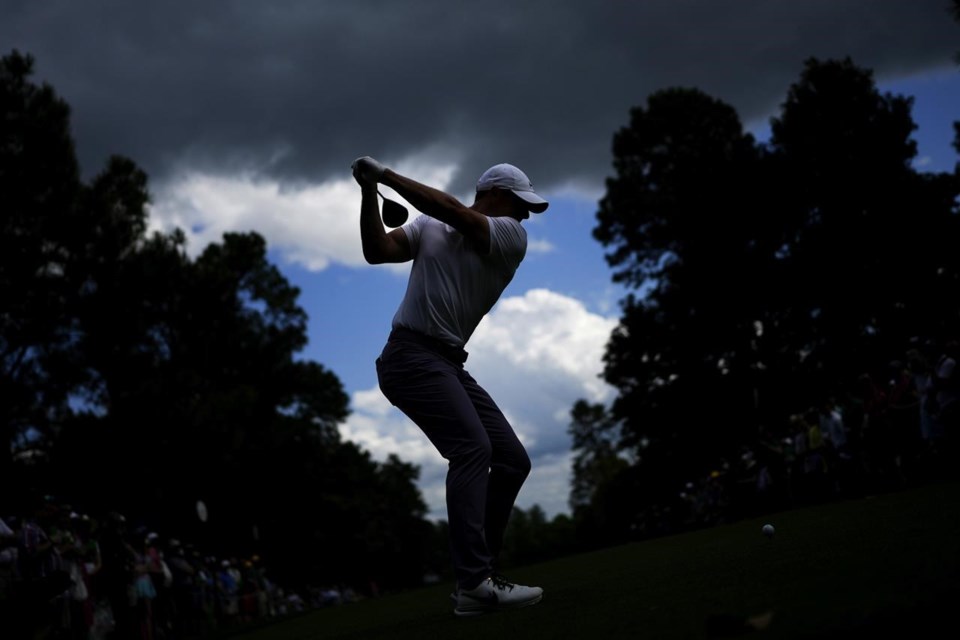AUGUSTA, Ga. (AP) — AP photographer Matt Slocum knows his way around the bucolic Augusta National Golf Club during the week of the Masters — it’s a difficult task with all the regulations that help preserve the aura of the tournament. So, when he saw the light and clouds combining for a perfect backdrop, he knew exactly where he should go to take some tee shots. He also knew how to stay ahead of the patrons to get to his perfect spot. Here’s what he had to say about making this extraordinary image.
WHY THIS PHOTO
The Masters is one of the most revered tournaments of professional golf — it’s also one of the toughest for photographers and golfers. One of golf’s four majors, it's full of history and tradition; rules and etiquette; joy and pain for both us and them.
Photographers are not allowed “inside the ropes” at the Masters — patrons are kept from the playing areas such as fairways and greens by ropes that mark the course. Being on the players’ side of the ropes give photographers better sight lines and ease of movement. But The Associated Press is lucky to have a good mix of photographers and editors onsite to help cover the tournament. We work together under the direction of David J. Phillip. With his vast Masters knowledge and experience, he guides us around the course as the day progresses and golfers charge up the leaderboard. Teamwork and communication are vital when covering this tournament. It’s tough to navigate the course quickly. You learn the hard way which crosswalks to avoid at peak times. Photographers that work together and are organized will have more success and less frustration overall.
Because we are not allowed inside the ropes, we tend to camp out at strategic spots and then leapfrog around before the crowds get too big. There are a few tee boxes that have access from behind. Patrons at the Masters are very polite and helpful when asked if we can kneel in front of them to get a key shot. By staying low, we don’t block them, and it allows us to emphasize the golfer and clean up the background. Once you find an area or light that is productive, you tend to work it, group after group to make scenic photos. You can vary the exposure and lens you use to add variety — wide, normal and telephoto.
HOW I MADE THIS PHOTO
In this case, golfers were teeing off toward the back of the box. I carried a fast, moderate-wide angle lens, a Sony 35mm F/1.4 GM and a Sony A1 mirrorless camera in anticipation of making this kind of photo. We are very lucky Sony is onsite to clean, repair and loan equipment. Not that I ever break anything, but many thanks to Van Nguyen, for replacing something I might have broken. I was shooting on a nearby hole when the clouds started to break and the blue sky appeared. This was my 14th Masters; I knew where to go in my area to line up a golfer with the sky.
I set my camera with the lowest native ISO, 100, to emphasize the dramatic sky. As golfer Rory McIlroy walked up the tee, I placed the camera very low and tried to keep him centered among the trees lining the hole. I just about always shoot at the widest aperture available, in this case F/1.4, to keep the emphasis on McIlroy. I was hunched way over on my knees, straining see the built-in level on the back of the screen. The camera was set to its fastest frame rate, 30 frames per second. I set the fastest shutter speed, 1/32,000th, to freeze all movement. I held the shutter release down for less than a second and made 22 crooked frames of the swing sequence. I picked a few visually pleasing moments to send to my editors Chris Carlson and Darron Cummings. It’s not obnoxiously crooked and has a nice feel, but it’s not perfect. “You can do better,” I hear from a ghost my head.
WHY THIS PHOTO WORKS
This photo is unique because of the clouds. There was a storm that delayed the start of the tournament that morning. It was dark and grey for most of the day. The shallow depth of field helps keep your eye focused on Rory. Using a very fast shutter speed helps make the bright areas of the image darker. It brings out the clouds, knocks down the crowd and freezes the golfer’s club at the top of his swing. The clouds are still breaking, framing the golfer and starting to add light on his swing.
___
For more extraordinary AP photography, click here.
Matt Slocum, The Associated Press



